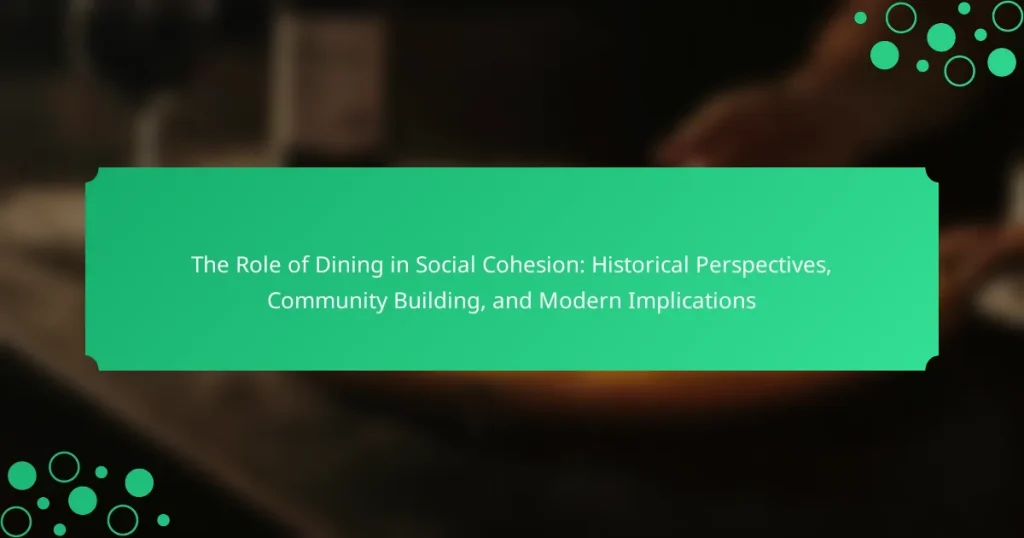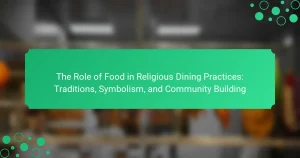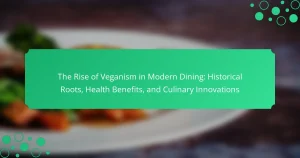Dining is a fundamental social practice that fosters connections and enhances social cohesion among individuals. This article explores the role of dining in building community ties, emphasizing how shared meals promote communication, trust, and group identity across various cultures. It examines historical perspectives on dining rituals, highlighting their significance in reinforcing cultural values and social structures. Additionally, the article discusses modern trends in communal dining experiences, the impact of technology, and the growing focus on inclusivity and sustainability in dining practices. Overall, the act of dining is presented as a vital mechanism for promoting social unity and emotional well-being.
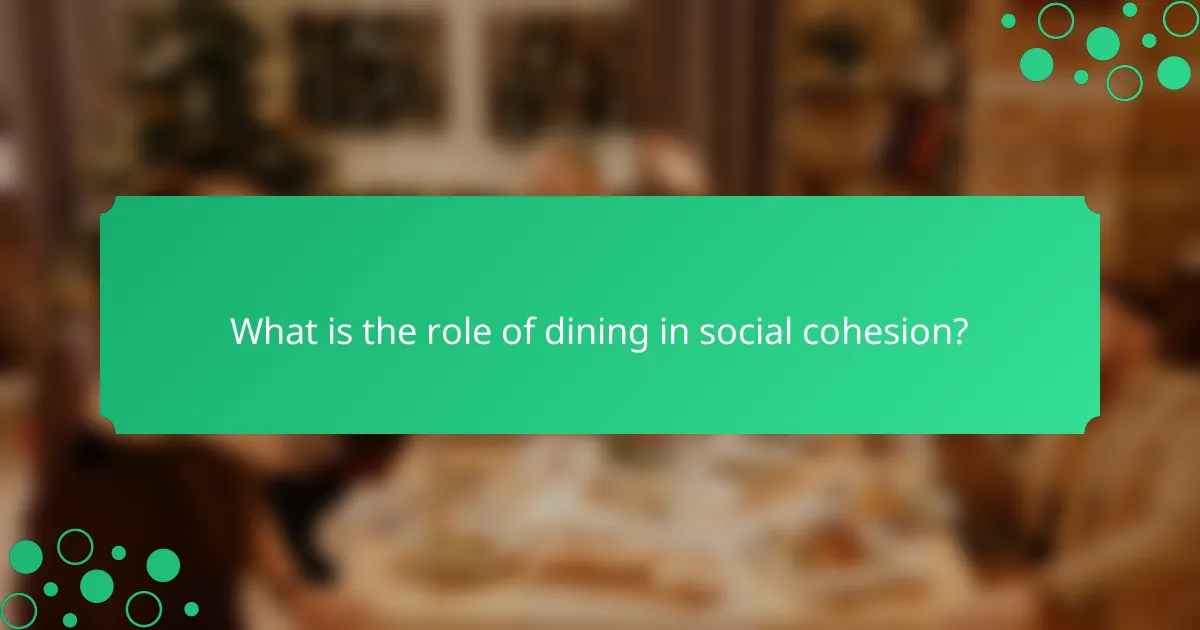
What is the role of dining in social cohesion?
Dining plays a crucial role in social cohesion by fostering connections among individuals. Shared meals create opportunities for communication and interaction. This communal experience strengthens relationships and builds trust within groups. Research indicates that dining together can enhance group identity and belonging. For instance, a study published in the Journal of Social Issues highlights how family dinners improve communication and reduce conflict. Additionally, dining rituals often reflect cultural values, reinforcing community ties. Overall, the act of dining serves as a vital mechanism for promoting social unity and cohesion.
How has dining historically contributed to social bonding?
Dining has historically contributed to social bonding by providing a communal space for interaction. Shared meals have fostered relationships among families, friends, and communities. In ancient cultures, communal feasts symbolized unity and cooperation. For instance, the Roman banquet served as a social gathering for bonding among participants. Additionally, dining rituals, such as toasting, have reinforced social ties. Historical records indicate that meals often marked significant life events, enhancing emotional connections. Furthermore, dining practices have evolved to include diverse cultural traditions, enriching social experiences. Thus, the act of sharing food has been a fundamental aspect of human connection throughout history.
What are some key historical examples of communal dining?
Key historical examples of communal dining include the Roman convivium, medieval feasts, and the traditional potlatch ceremony among Indigenous peoples. The Roman convivium was a social gathering where guests shared a meal, often accompanied by entertainment. These events were crucial for building social ties and political alliances in ancient Rome. Medieval feasts were large communal gatherings that celebrated significant events, such as weddings or harvests. They fostered community spirit and reinforced social hierarchies. The potlatch ceremony involved communal feasting and gift-giving among Indigenous peoples of the Pacific Northwest. This practice served to strengthen community bonds and establish status within the tribe. Each of these examples illustrates the importance of shared meals in promoting social cohesion throughout history.
How did cultural practices around dining evolve over time?
Cultural practices around dining evolved significantly from ancient times to the present. In ancient societies, communal meals were central to social bonding and ritual. For instance, the Greeks and Romans held symposia, which were gatherings for philosophical discussions over food. During the Middle Ages, dining became more formalized with the introduction of etiquette and structured meals, often reflecting social hierarchy. The Renaissance period saw an emphasis on elaborate feasts, showcasing wealth and artistry in food presentation.
In the 19th century, the rise of the middle class led to more diverse dining practices, including the popularity of restaurants. The 20th century introduced fast food and casual dining, reflecting changing social dynamics and lifestyles. Today, dining practices continue to evolve, influenced by globalization and technology, with trends like farm-to-table and food sharing gaining popularity. These shifts illustrate how dining practices have consistently mirrored societal changes and cultural values throughout history.
Why is dining considered a fundamental aspect of community building?
Dining is considered a fundamental aspect of community building because it fosters social interaction and connection. Shared meals create opportunities for conversation and relationship development. Dining together promotes a sense of belonging among individuals. Research shows that communal eating enhances trust and cooperation within groups. Historical practices, such as family dinners or community feasts, illustrate the role of food in uniting people. Additionally, dining experiences often reflect cultural traditions, reinforcing group identity. The act of sharing food symbolizes generosity and hospitality, essential for community bonds. Overall, dining cultivates a shared experience that strengthens community ties.
What psychological effects does shared dining have on individuals?
Shared dining has positive psychological effects on individuals. It fosters a sense of belonging and community. Engaging in shared meals can enhance social bonds and reduce feelings of loneliness. Studies show that communal eating encourages communication and strengthens relationships. Research indicates that shared dining experiences can lead to increased happiness and satisfaction. Individuals report feeling more connected to others during group meals. Additionally, shared dining can promote healthier eating habits through social modeling. Overall, the psychological benefits of shared dining contribute to improved mental well-being.
How does dining facilitate communication and connection among people?
Dining facilitates communication and connection among people by creating a shared space for interaction. Shared meals encourage conversation and foster relationships. The act of dining together promotes bonding through shared experiences. Research shows that communal meals enhance social ties and improve emotional well-being. For example, studies indicate that families who dine together regularly report stronger relationships. Dining also provides a platform for storytelling and cultural exchange. This exchange deepens understanding and strengthens community ties. Overall, dining acts as a catalyst for social engagement and connection.
What modern implications does dining have for social cohesion?
Dining plays a significant role in fostering social cohesion in modern society. Shared meals create opportunities for interpersonal connections. They promote communication and strengthen relationships among individuals. Dining together encourages a sense of belonging and community. Research shows that communal eating can enhance trust and collaboration. For instance, studies indicate that families who dine together regularly experience stronger bonds. Additionally, dining events can bridge cultural divides, facilitating understanding among diverse groups. Overall, the act of dining serves as a vital tool for enhancing social ties in contemporary contexts.
How has the rise of technology changed the way we dine together?
The rise of technology has significantly transformed how we dine together. Digital platforms enable virtual dining experiences, allowing people to connect regardless of location. Online food delivery services have made meals accessible, promoting shared dining even from a distance. Social media influences dining choices and trends, fostering community engagement around food. Apps facilitate reservations and streamline group dining logistics, enhancing the overall experience. Video conferencing tools allow families and friends to share meals virtually, maintaining social bonds. Technology has also introduced smart kitchen devices, making cooking more efficient and interactive. These changes reflect a shift in social dynamics, emphasizing convenience and connectivity in dining experiences.
What role do restaurants and cafes play in fostering community?
Restaurants and cafes play a crucial role in fostering community by serving as gathering spaces. They provide environments where people can connect, share experiences, and build relationships. These establishments often host events that encourage social interaction, such as open mic nights and community dinners. According to a study by the National Restaurant Association, 70% of diners believe that restaurants contribute to the local community. Additionally, they support local economies by sourcing ingredients from nearby farms and vendors. This creates a sense of belonging and strengthens community ties. Through these interactions, restaurants and cafes help cultivate a vibrant social fabric.
What challenges does dining face in promoting social cohesion today?
Dining faces several challenges in promoting social cohesion today. One major challenge is the increasing pace of modern life. Many people prioritize convenience over shared meals. This leads to fewer opportunities for communal dining experiences. Additionally, cultural diversity can create barriers. Different food preferences and dietary restrictions may hinder group dining. Economic disparities also play a role. Not everyone can afford to dine out, limiting inclusivity. Furthermore, the rise of virtual interactions has reduced face-to-face dining. This shift impacts social bonding that occurs during shared meals. Lastly, health concerns, such as food allergies and hygiene, create apprehension in communal settings. These factors collectively challenge dining’s role in fostering social connections.
How do socioeconomic factors influence dining practices and social interactions?
Socioeconomic factors significantly influence dining practices and social interactions. Individuals from higher socioeconomic backgrounds often dine at upscale restaurants, reflecting their financial capacity. This choice can foster exclusive social networks and reinforce class distinctions. Conversely, those from lower socioeconomic backgrounds may prefer affordable dining options, impacting their social interactions. These dining settings often emphasize communal experiences, promoting social bonding among peers. Research indicates that dining together can enhance social cohesion, especially in diverse communities. For instance, a study by the Pew Research Center found that shared meals can bridge cultural gaps and foster understanding. Thus, socioeconomic status shapes not only where people eat but also how they connect with others.
What are the barriers to inclusive dining experiences in diverse communities?
Barriers to inclusive dining experiences in diverse communities include cultural misunderstandings, accessibility issues, and economic disparities. Cultural misunderstandings can lead to misinterpretations of dietary restrictions or preferences. Accessibility issues often arise from physical barriers in restaurant design or lack of transportation options. Economic disparities can limit participation in dining experiences due to high costs. Additionally, language barriers may prevent effective communication between staff and patrons. These factors collectively hinder the creation of welcoming dining environments for all community members.
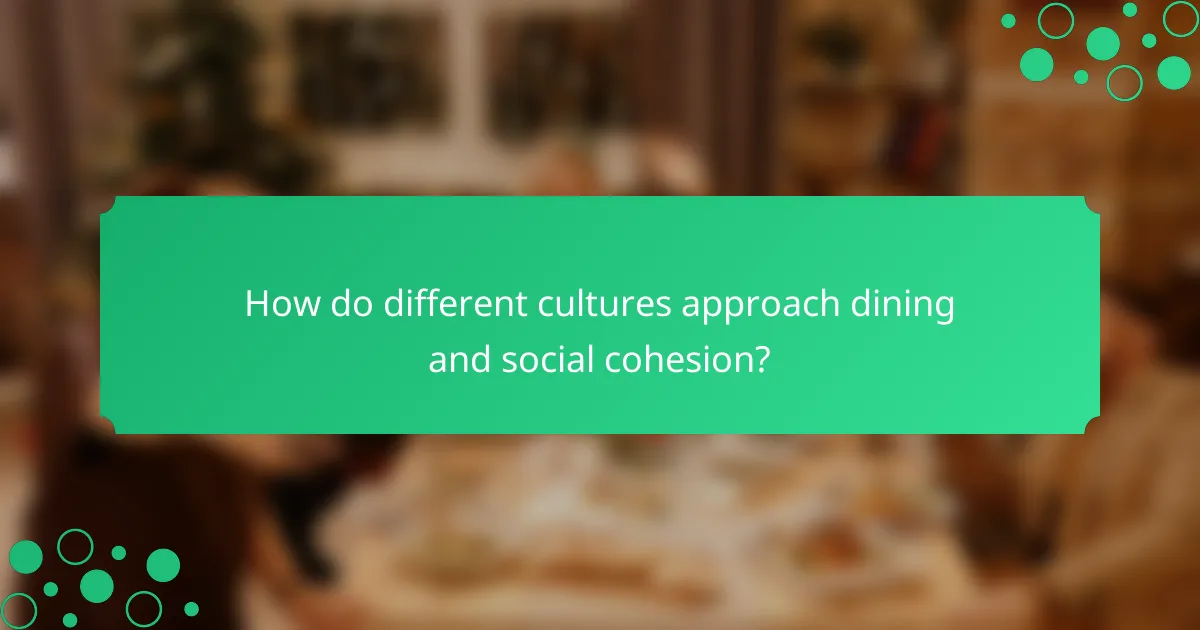
How do different cultures approach dining and social cohesion?
Different cultures approach dining as a vital means of fostering social cohesion. In many societies, shared meals serve as a critical social ritual. For example, in Mediterranean cultures, communal dining enhances relationships and strengthens family bonds. In contrast, Asian cultures often emphasize respect and hierarchy during meals, reflecting social structures.
Indigenous cultures frequently incorporate traditional foods into communal gatherings, reinforcing cultural identity. In Western societies, dining can be both formal and casual, impacting social interactions differently. Research shows that shared meals can improve communication and promote trust among participants.
The act of dining together creates a sense of belonging and community. Studies indicate that regular family meals correlate with better emotional well-being in children. Overall, dining practices reflect and shape the social fabric of various cultures.
What unique dining traditions exist across various cultures?
Unique dining traditions vary significantly across cultures. In Japan, the practice of eating sushi emphasizes seasonal ingredients and presentation. Italians often enjoy family-style meals, fostering communal sharing and bonding. In Ethiopia, injera is used as both a plate and utensil, promoting a shared dining experience. The Mexican tradition of sharing a meal during Día de los Muertos honors deceased loved ones through food offerings. In India, meals are often served on banana leaves, symbolizing hospitality and respect. These traditions reflect cultural values and promote social cohesion within communities.
How do these traditions reflect social values and norms?
Dining traditions reflect social values and norms by reinforcing community bonds and cultural identity. Shared meals promote social interaction and strengthen relationships among participants. These traditions often embody respect for heritage and family, showcasing customs passed down through generations. For example, communal dining practices highlight values like hospitality and generosity. In many cultures, specific foods symbolize abundance and celebration, reinforcing societal ideals. Historical practices, such as feasting during harvest, illustrate collective gratitude and unity. Thus, dining traditions serve as a microcosm of broader societal values, reflecting the importance of togetherness and shared experiences.
What role does food play in cultural identity and community ties?
Food serves as a crucial element in shaping cultural identity and fostering community ties. It reflects traditions, values, and shared histories within a group. Specific dishes often symbolize cultural heritage and are central to celebrations and rituals. For instance, traditional meals during holidays reinforce collective memory and belonging. Food practices can create a sense of unity, as families and communities gather to prepare and share meals. Research shows that communal dining promotes social bonding and strengthens relationships. A study by the University of Oxford found that shared meals enhance feelings of connectedness among participants. Thus, food not only sustains individuals but also nurtures the fabric of communities.
How can dining practices be adapted to enhance social cohesion in modern society?
Dining practices can be adapted to enhance social cohesion by promoting communal meals and inclusive dining experiences. Shared meals encourage interaction and foster relationships among participants. Organizing regular community dinners can create a sense of belonging. Diverse menus that reflect the community’s cultural backgrounds can promote inclusivity. Additionally, hosting themed dining events can spark conversations and connections. Research shows that communal dining can reduce social isolation and strengthen community ties. Studies indicate that neighborhoods with active dining events report higher levels of social trust and cooperation. Implementing these practices can significantly enhance social cohesion in modern society.
What are some innovative dining concepts that promote inclusivity?
Innovative dining concepts that promote inclusivity include community kitchens, pop-up restaurants, and themed dining events. Community kitchens allow diverse groups to cook and share meals together. This fosters collaboration and cultural exchange among participants. Pop-up restaurants often feature cuisines from various cultures, inviting people to experience new flavors and traditions. Themed dining events, such as those focusing on disability awareness or cultural celebrations, create spaces for dialogue and understanding. These concepts encourage social interaction and break down barriers. Research shows that shared meals can enhance social bonding and community ties.
How can community events centered around dining strengthen local bonds?
Community events centered around dining strengthen local bonds by fostering social interaction. Shared meals create opportunities for people to connect and communicate. These gatherings encourage collaboration and teamwork through shared responsibilities, such as meal preparation. Dining events often highlight local culture and traditions, enhancing community identity. Research shows that communal dining can improve trust and cooperation among participants. For example, a study by the University of California found that shared meals increase feelings of belonging. Additionally, dining events can attract diverse groups, promoting inclusivity and understanding. Overall, these events serve as a platform for building lasting relationships within the community.
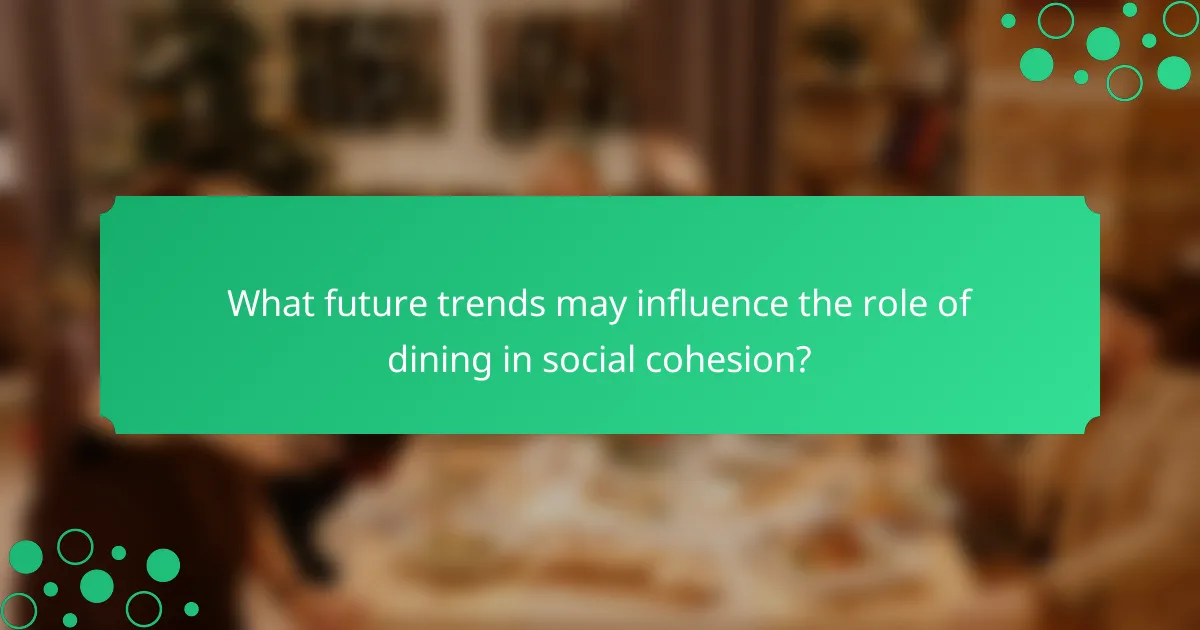
What future trends may influence the role of dining in social cohesion?
Future trends influencing the role of dining in social cohesion include the rise of communal dining experiences. These experiences foster interaction among diverse groups, enhancing relationships. Increased focus on local and sustainable food sources also promotes community ties. As people prioritize health and wellness, dining venues may adapt to accommodate dietary preferences, reflecting inclusivity. Technology integration, such as online reservations and food delivery, allows broader participation in dining experiences. Social media platforms further amplify communal dining events, connecting individuals and communities. These trends collectively strengthen the social fabric through shared culinary experiences.
How is the concept of dining evolving in the context of globalization?
The concept of dining is evolving through increased cultural exchange and fusion cuisines. Globalization facilitates the sharing of culinary traditions across borders. This leads to diverse dining experiences that blend various cultural elements. Restaurants now offer international dishes alongside local favorites. Food festivals showcase global cuisines, promoting community engagement. Social media amplifies food trends, influencing dining choices worldwide. Additionally, dining has shifted towards more casual, communal settings. This evolution reflects a growing appreciation for multiculturalism in gastronomy.
What impact does fusion cuisine have on social interactions?
Fusion cuisine enhances social interactions by promoting cultural exchange and diversity. It brings together different culinary traditions, encouraging shared experiences. Dining on fusion dishes often sparks conversations about cultural backgrounds. This interaction fosters understanding and appreciation of various cultures. Studies show that shared meals can strengthen social bonds. Fusion cuisine events, like food festivals, create communal spaces for engagement. These gatherings often lead to new friendships and connections. Overall, fusion cuisine serves as a bridge in multicultural societies, enhancing social cohesion.
How might sustainability trends shape communal dining experiences?
Sustainability trends are reshaping communal dining experiences by prioritizing eco-friendly practices. These trends encourage the use of locally sourced ingredients. This reduces carbon footprints associated with transportation. Restaurants are increasingly adopting zero-waste policies. Such policies minimize food waste and promote recycling. Communal dining settings are integrating plant-based menus, appealing to health-conscious diners. Research indicates that plant-based diets can lower greenhouse gas emissions. Additionally, communal dining fosters a sense of community around shared values of sustainability. This enhances social interactions among diners. Overall, sustainability trends are transforming how communities engage through dining experiences.
What practical strategies can individuals and communities adopt to enhance social cohesion through dining?
Individuals and communities can enhance social cohesion through dining by organizing communal meals. Shared dining experiences foster connections among participants. This can include potlucks, where everyone contributes a dish. Such events encourage interaction and cultural exchange. Establishing regular dining gatherings builds familiarity and trust. Community kitchens can serve as inclusive spaces for cooking and sharing meals. Cooking classes can also be organized to teach culinary skills and promote teamwork. These activities often lead to lasting friendships and community bonds. Research shows that shared meals improve social ties and reduce isolation.
How can organizing communal meals foster stronger neighborhood ties?
Organizing communal meals fosters stronger neighborhood ties by creating opportunities for social interaction. Shared meals encourage residents to engage in conversation and build relationships. This interaction can lead to a sense of belonging and community identity. Research shows that neighborhoods with frequent communal activities report higher levels of trust among residents. A study by the University of Michigan found that communal dining increases social capital. Social capital is essential for community resilience and support networks. Additionally, communal meals can bridge cultural divides by bringing diverse groups together. This inclusivity promotes understanding and cooperation among neighbors.
What are some best practices for inclusive dining events?
Best practices for inclusive dining events include offering diverse menu options. This ensures that dietary restrictions and preferences are accommodated. Consider vegetarian, vegan, gluten-free, and allergen-free choices. Clear labeling of all food items is essential. It helps attendees make informed decisions about what they can eat.
Setting up the dining area to promote accessibility is crucial. Ensure pathways are clear and seating is adaptable for individuals with mobility challenges. Additionally, creating a welcoming atmosphere fosters social interaction. Use inclusive language in invitations and announcements to encourage participation from all community members.
Providing interpreters or translation services can aid non-native speakers. This enhances communication and ensures everyone feels included. Finally, gathering feedback post-event can help improve future gatherings. Listening to participants’ experiences promotes continuous inclusivity.
The main entity of the article is dining, specifically its role in social cohesion. The article explores how dining fosters connections among individuals, enhances group identity, and reflects cultural values, drawing on historical examples and modern implications. It discusses the psychological effects of shared meals, the impact of technology on dining practices, and the challenges faced in promoting inclusivity. Additionally, it examines how different cultures approach dining and the innovative concepts that can strengthen community ties, ultimately emphasizing the importance of communal meals in building social bonds.
